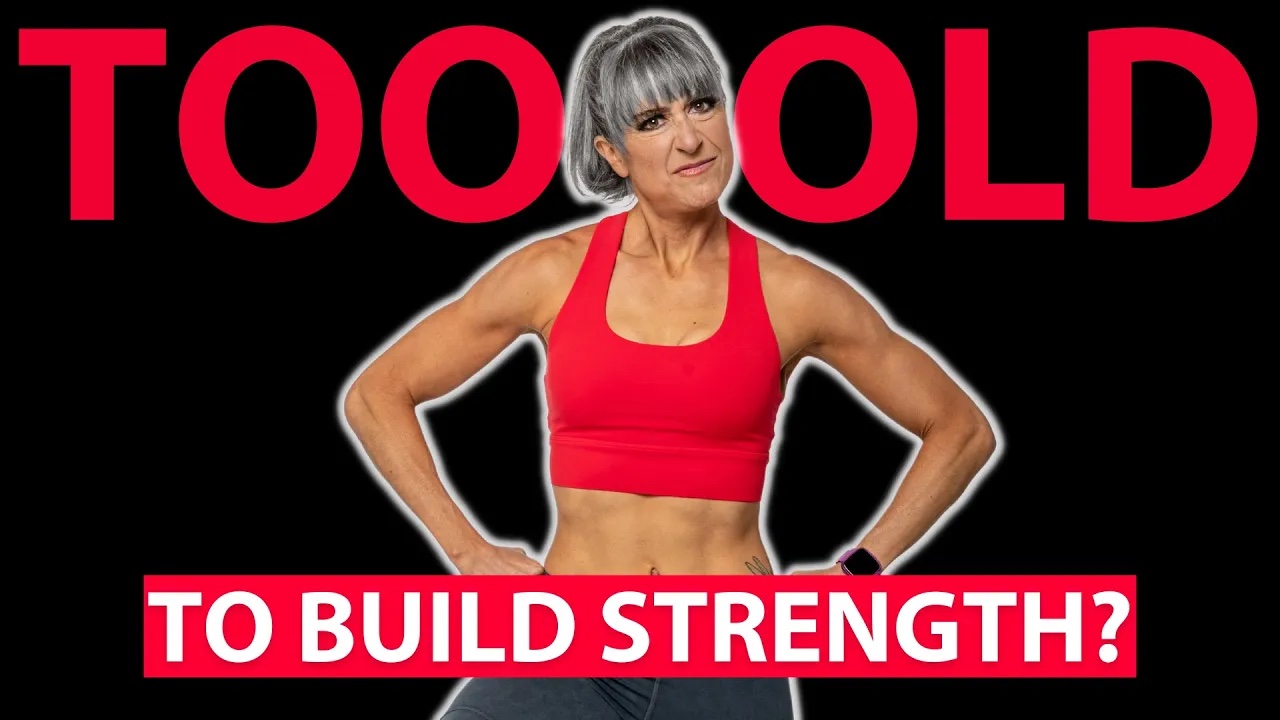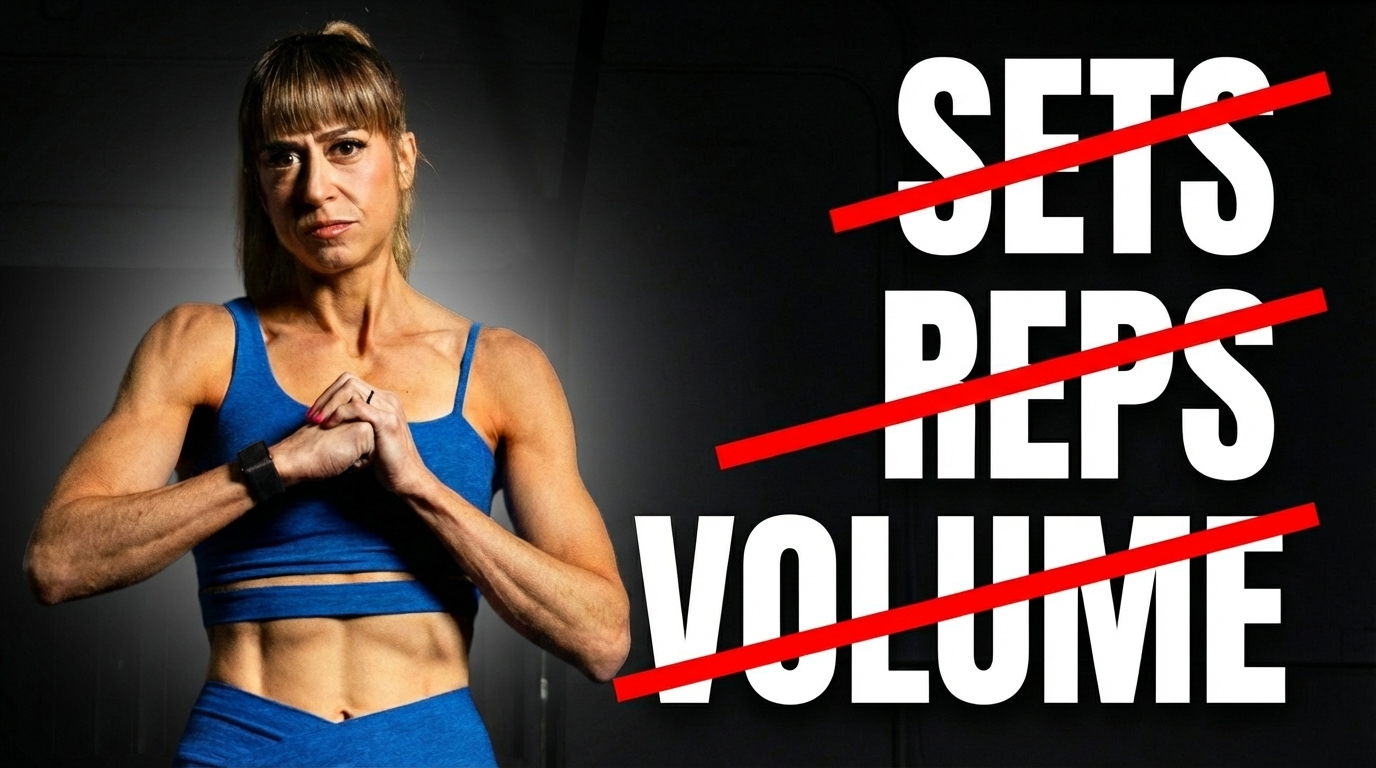Being strong can mean so many different things. And our strength goals change as we get older. Our priorities can shift.
But if you’re looking for the best way to build strength as you get older so you can move, feel and look your best then this video and the 3 tips I’ll go over are key.
At the end of the video, I’ll also share one of my favorite ways of loading down moves to improve your stability, balance and core strength!

Hey guys it’s Cori from Redefining Strength where we help you feel, look and move your best at any and every age.
While we may want to increase our deadlift weights, learn to rep out those pull ups or master specific movements, building strength as we get older is also about maintaining our mobility and being able to conquer any challenges life throws at us.
We want to be able to vacation and hike, kayak, paddle board or enjoy the activities we love.
We want to avoid aches and pains and feel and move our best while also looking fabulous.
That’s why I wanted to share the best way to build strength at any age and 3 tips to help you improve your workouts.
At the end of the video I’ll also talk about an underutilized way of increasing the resistance you use on moves to improve your stability, balance and core strength!
When we’re working to build strength, often we get focused on lifting heavier. Or doing a harder variation.
But we have to remember that strength comes from the ability to recruit the correct muscles at the correct times in the correct order to the correct extent.
You can lift more because you’re able to recruit muscles faster and more efficiently.
It’s why if you want to build strength at any age, you can’t ignore the importance of improving your mind-body connection.
And especially as we get older, often we see our balance decline and reactions slow because our mind-body connection isn’t as strong.
It’s why we need to be intentional with our training and focus on what we feel working.
It’s why it is key, during our workouts, we constantly ask ourselves, “What do I feel working?”
Because what we feel involved in the movement is what is benefiting from the exercise.
If you perform a deadlift and only feel your lower back, you won’t see the results from that hip hinge movement that you want.
You may even end up with lower back aches and pains.
It’s why you need to constantly assess what muscles are powering the movements to modify the exercises, change your cues and form or even try a different variation until you can make sure you’re recruiting the correct muscles.
Because no matter how amazing the move supposedly is, you won’t get the benefits and strengthen the muscles you want to strengthen if you don’t feel them working.
Strength isn’t built by performing an exercise while mimicking proper form – it’s built by using the correct muscles to do the movement.
If you focus on improving your mind-body connection so you can feel the correct muscles working, you’ll ultimately get stronger and be able to lift more and tackle those harder exercise variations while putting yourself at less risk for injury!
As you focus on what you feel working during exercises, earning those harder variations as you go, you want to dial in your training implementing these tips….
Tip #1: Focus on unilateral moves.
Unilateral or one sided moves can be awkward.
They can be uncomfortable.
They can make us feel off balance and force us to use lighter weights than we could lift with a bilateral or two-sided variation.
But they truly are essential if we want to stay functionally strong as we get older.
They help improve our balance, stability and core strength.
Unilateral moves also isolate each side to help us correct imbalances to be able to lift more while avoiding future injury.
While ideally we’d never be injured the simple fact is that often, as we get older, injuries and aches and pains tend to add up.
Because of these previous injuries, and just the fact that in everyday life we tend to have a dominant side we favor, we often have strength imbalances between both sides.
Including unilateral moves can not only help us correct these imbalances, but they can prevent our stronger side from taking over and working harder.
This can lead to us ultimately seeing gains even in those bilateral lifts because each side is pulling its weight!
So include variations like the single arm bench press or a single leg squat to bench even.
They will challenge your body in new ways to improve your mind-body connection and help you build that functional strength you need to take on any challenge that comes your way as you get older!
They can even help you improve your mobility by allowing you to truly strengthen through a full range of motion!
Tip #2: Move in every direction.
Staying functionally strong and mobile means moving in every direction. We need to learn how to control all of the joint actions our body can perform.
That’s why it is key we include anti-rotational but also rotational moves.
It’s also why it is key we include pushing, pulling, hinging and squatting movements that address the different planes of motion.
For example, consider the lunge.
So often we just lunge forward or backward.
We progress the move by adding loads or by increasing the range of motion.
But there are so many other angles we can lunge in to improve our hip and knee stability, not to mention target different muscles to different extents.
The side lunge is a great way to target your glutes and adductors more.
The curtsy lunge can be a great lunge variation to work your glutes more.
While the front angled lunge can be a great way to target your quads and adductors to a greater extent.
And lunging in all of these different directions can help you keep your legs strong and knees and hips healthy.
If you do have previous knee issues, you can do many of these lunges still by lunging shorter or by reducing active knee flexion as you do the other mobility work you need.
But moving in every direction to strengthen muscles using all of the joint actions they control is so key to staying strong as we get older!
Tip #3: Focus on compound movements, especially ones that challenge your coordination.
As we get older we tend to want to shy away from uncomfortable and more complicated movements.
But challenging our coordination keeps not only our body but also our mind strong.
So including compound and hybrid movements that challenge our coordination improves our mind-body connection to help us build strength.
I’ve had many clients get frustrated by the bodyweight sit thru. It’s an awkward movement pattern many of us haven’t done before.
But by learning to control this rotational move, they improve their rotational core strength as well as their shoulder and hip stability.
And by learning to perform this new movement pattern, they improve their ability to recruit muscles quickly in a new way.
The more we are able to call on whatever muscles we need whenever we need them the stronger we will be. And the more able to tackle new challenges and avoid falls and injury.
So that climber push up or deadlift to row exercise you’ve been avoiding, stop avoiding it.
You may have to modify. You may have to reset or correct yourself. But by conquering this new challenge you’ll ultimately build strength.
Progression doesn’t just come through adding loads.
The challenge of new movement patterns and combinations pays off!
The final tip, and a great way to add loads and build functional strength while creating instability and an anti-rotational core challenge is with offset weights or offset loading.
With offset loading you will use a weight that has a heavier load on one side.
This may mean using two dumbbells of different weights or even a barbell loaded unevenly.
You will want to start light with this as it is deceptively hard.
But you will use the uneven load to challenge your body to fight against wanting to rotate or lean because of the difference in loads.
This is super key as often, in every day life, we are carrying awkward objects or things that are a different weight on each side.
And with this offset loading, remember you can even change the loading placement.
Often we get very used to just loading in one way, like with dumbbells held down by our sides.
But you can also hold dumbbells up at your shoulders or even front load with kettlebells.
So include not only uneven loads to challenge your stability and strength but also vary up your loading placement to target and include even different muscles in your basic exercises.
Building strength, especially as we get older, is about focusing on that mind-body connection, addressing imbalances to improve our balance and stability while challenging our body to not only lift heavier but move in every direction.
Using these 3 tips you can improve your strength gains from your workouts at any age.
And if you’re looking to not only increase your strength but also build muscle as you get older, check out my How to Build Muscle At Any Age (7 TIPS!) next!
–> How to Build Muscle At Any Age (7 TIPS!)



love this!! I am slim, fit, in shape … 4 time Ironman triathlete who in the offseason (and tax season..I’m a CPA) does cardio 6 days a week and lifts 5 days a week…going to hike 7 days in AZ, UT will my 26 year old daughter in May.
I’m 63. Thinking I should work on balance more…will do your uneven load moves….anything else? When my daughter graduates in May and works FULL TIME and my son gets married in October, I’ll probably be contacting you for a program to just even get better than I am now!
Always here to help Dawn! Unilateral moves will be great as well!